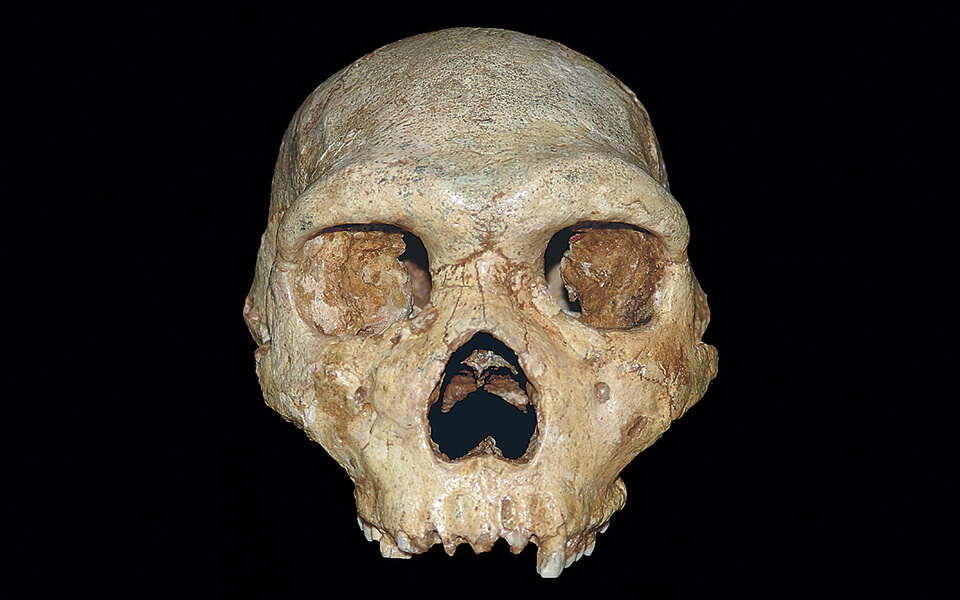
In 1959, a 700,000-year-old human skull known today as the “PetralonaMan” or “PetralonaArchantrop” was discovered. Since then,scientists have wondered where exactly this skull came from, sparkingmuchdebate.

Askull found in a cave wallat Petralona, nearHalkidiki,northern Greece, is believed to be the oldest human “European”(with European features). A shepherd accidentally discovered acavefullof stalactites and stalagmites.
In the yearsthatfollowed, researchers also uncovered a wealth of fossils, including pre-human species, animal hair, petrified wood, stone and bone tools, and other artifacts. The President of the municipalityof Petralona donated the skull to the University of Thessaloniki, Greece. T
he contractprovidedfortheopeningofamuseumtodisplaythefindsfromPetralonaCave once the investigationswerecomplete, and the returnofthe skull fordisplay in the museum.
However, this promise was never kept.dr Aris Poulianos, an anthropology expert then working at MoscowStateUniversity,wascommissionedtoconductastudy of the skull and cavity.
He was a member of IUAESUNESCO,i.e. the International Union of Anthropological and Ethnological Sciences. Helater founded the Anthropological Society of Greece.

Anearlierworkby Dr. Poulianosentitled”The Origin of the Greeks” had already brought him fame. His research on the cranial and anthropometric features of modern Greeks servedas the basis for his thesis, which proved that modern-day Greeks are descendants of ancient Greeks and not Slavic peoples.dr Poulianos has beenstudying early hominid remains discovered in a cave in Petralona, Greece, since the 1970s and is known for his controversial age estimates. according to dr Poulianos, thePetralonaCave was accidentallydiscovered in 1959 by villagers looking for a spring onthe mountainside.
The presence of manycaves in a country where 65% of the soil is calcareousiscompletely natural.
Inaddition, Greece is the second richestcavecountryintheworld,rightafter China. Thousands of these formations have been surveyed,mapped and studied, and morethan 100 have proventobe of particular interest to visitors.
The “PetralonaMan”, also known as theArchanthropist of Petralona, hasbeenestimated to be 700,000 years old, making him the oldest European of thisperiod ever found in Europe. Thankstotheresearchof Dr. Poulianosfound that Petralona man is not nativetoAfrica, but evolved autonomously in Europe.
The “Out of Africa”theorysuggests that “anatomically modern humans”called”Homosapiens”appeared in Africa 200,000 to 100,000 years ago before spreading to the rest of the world. This view was based on the fact that most prehistoric fossils were found in Africa.
In 1964, two German researchers, Breitinger and Sickenberg, tried to replicatethefindingsof Dr. Poulianos by claiming that the skull is only 50,000 years old and came from an ancestor from Africa.
However, research published in 1971 in the prestigiousUSjournalArcheology confirmed that the skull wasactually 700,000 years old.
This was determined by examining the cave and the layersof sediment inwhich the skull was found. Further explorationof the cave hasresultedin the discovery of fossils of many different species, single teeth and two pre-human skeletonsdatingfrom 800,000 years ago.
In September 1995, Dr. Poulianos a calcified tibia found atMullet in Chalkidiki, which he said belonged to a formof Homo erectus,which he called Homo erectus trilliensis, whichspread from this region of the AegeanSeainsouth-easternEuropearound the world. million years ago and datesback to 11 million years before present. Poulianos believes his discovery couldundermine the “MyAfrica”theory of human evolution.
Most scholars who have examinedPetralona’sremains say that ArchanthropistPetralona’sskullcame from an ancient manother than Homo erectus. And traditional Neanderthals and modern humans in terms of anatomy, but with features of all three species and strong European features.
A 700,000-year-old skull derivedinwholeorinpart from Homo sapiens contradicts the “MyAfrica”theory of humanevolution.
Internationalscientists (46 specialists from 12 countries) continued the excavations in the PetralonaCave,providingfurther evidence for theclaimsof Dr.
Poulianosdelivered.It includes petrified wood, oak leaves, animal hair, and coprolitesthathaveallowed accurate dating, as well as the almost continuous presence of stone and bone tools from the lower (750,000 years) to the upper (550,000 years) stages of archanthropicevolution.years)ofthe sediment layerof the cave.
The research was carriedout until 1983, with an interruption dueto the dictatorship in Greece. The government then banned any further excavationof the siteforthenext15years,even by the original archaeological team.
No one had access to the grounds or the exhibits and no explanation was given. However, Dr.Poulianos’ research was buried because it contradicted the prevailing theory of human evolution at the time. In 2012dr. Poulianos and his wife were attacked and injured, but those responsible were found.
He and his team wereunable to return to the cave to completethesearch, and the skull’slocation is currently unknown. Source: Collective-Iskra.xyz






